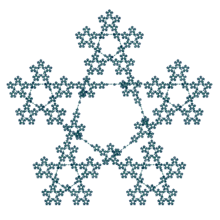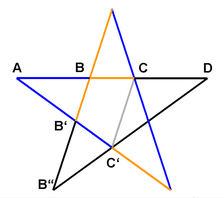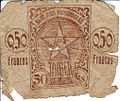Pentagram
Pentagram (from ancient Greek πέντε pénte "five" and γραμμή grammē "line, dash"; πεντάγραμμος pentágrammos "with five lines") denotes a shape of the five-pointed star , also called five-star , which results if one is created every time when connecting the five corner points or two are skipped and the chords thus generated are of the same length. This regular star is noted with the Schläfli symbol or . The terms Drudenfuß or Drudenstern , Pentakel and are also widespreadPentalpha , as it can be formed from five interconnected alphas ("Α"). Since the pentagram has five points, there are two basic types of orientation: with one point up (then two points down and two to the side), or with one point down (then two points up and two to the side ). The latter is also known as the "inverted" or "inverted" pentagram.
Unicode
The pentagram is included in the Unicode block Various symbols . At code point U + 26E4 (9956) ⛤ under the name “PENTAGRAM” and at code point U + 26E7 (9959) ⛧ as “INVERTED PENTAGRAM”.
geometry
construction
Even five, so at intervals of 72 ° on a circular distributed points can be made using tendon two five-axis symmetrical figures create:
- The five chords between neighboring points form a regular pentagon with angles of 108 ° each.
- The five chords between non-adjacent points together form the pentagram with acute angles of 36 °.
Geometric properties
The inner sections of the chords of the pentagram in turn form a regular pentagon . Compared to the outer one, it is rotated by 36 °. The points of the pentagram are isosceles triangles . The angles between the base and legs of these triangles are 72 °.
The inner pentagon , together with two non-adjacent prongs, forms an isosceles triangle with an obtuse tip, the already mentioned 108 ° angle .
To draw in the inner pentagon again a pentagram, thus forming the chord with portions of the chords of the outer pentagram also isosceles triangles with blunt tip of 108 °. Their perpendiculars are parallel to those of the jagged triangles, which in turn form the axes of symmetry of all pentagrams and pentagons.
The outer pentagon , pentagram and inner pentagon have the same center . Each chord of the inner pentagram runs parallel to a chord of the outer pentagram beyond the center.
All angles between the edges of the pentagram and the surrounding pentagon are therefore 36 °, 72 ° or 108 °. The five axes of symmetry have angles of 18 °, 54 ° and 90 ° to the edges.
Golden cut
All chords and chord parts delimited by intersection points of a pentagram including the outer and inner pentagon have only four different lengths . Of these, successive ones are in the ratio of the golden ratio , i.e. H. the following aspect ratios are the same:
Because it applies z. B. for the first ratio:
The triangle is isosceles , as there is a proportional reduction of the isosceles triangle is because the internal angle of the two triangles are identical.
- and
Based on the theorem of rays :
Let's look at the relationship
- ,
then is and thus corresponds to the definition of the golden ratio , thus applies .
Formulas
| Mathematical formulas for the pentagram | ||
|---|---|---|
| Area |

|
|
| scope | ||
| Length of the tendon | ||
| Side length of the inner pentagon | ||
| Side length of the outer pentagon | ||
| Perimeter radius | ||
Polyhedron with pentagrams
Some polyhedra have pentagrams as faces , for example the dodecahedral star and the icosahedral star . These two polyhedra are Kepler-Poinsot solids .
flora
The pentagon appears in different contexts in nature, so it is a characteristic of the common hollyhock .
History and cultural significance
Antiquity
The pentagram was the symbol of Venus , both the planet and the goddess . It was made on a jug from the Mesopotamian Djemdet-Nasr period, i.e. H. around 3000 BC BC, found as an ideogram of the Sumerian goddess Inanna / Ištar .
Pythagoras knew it as a symbol of health. He was particularly interested in the mathematical aspect of the golden ratio . Since you can draw it in one go and get back to the beginning at the end, it was also considered a symbol for the cycle of life. Abraxas , god of the Gnostics , was also symbolized by a pentagram because he unites five primal forces.
heraldry
The Drudenfuß is also used as a common figure in heraldry , i.e. on coats of arms and flags . Morocco and Ethiopia have a drudenfoot in their flags, municipalities such as Knielingen , Giebenach and Schlotheim in their coats of arms.
In sacred buildings

The pentagram with its golden section shaped many churches . Pentagrams can still be seen today on many rose windows in Gothic church buildings. A Drudenfuß can also be seen on the east side of the tower of the Marktkirche Hannover . A Christian interpretation for the five corners is the five wounds of Jesus Christ .
Masonic symbol
From the cathedral construction huts , the pentagram came to the Freemasons and became the overarching symbol on their work carpets. Its five points indicate the virtues of prudence, justice, strength, moderation, and industry.
Further symbolic interpretations of the five corners of the pentagram are the spirit and the four elements fire, water, earth and air; or ether and the four cardinal points north, south, west and east.
The Blazing Star is a Masonic pentagram by a halo surrounded and centrally the letter G contains (same meaning).
numismatics
As a symbol on coins , the pentagram has been detectable on Merovingian coins since the early Middle Ages . It can also be found in large numbers on the coins and banknotes of French Morocco . Examples:
Pentacle
The pentagram, especially when it is enclosed in a circle, is also used as a symbol for amulets and is called the pentacle . The word can also generally designate amulets for magical conjuration , even if there is another symbol on them.
Religion and occultism

In medieval and post-medieval times, the pentagram was used as a sign of excommunication against evil and as a symbol of magic and defense against demons . The name Drudenfuß is explained on the one hand by the fact that the symbol was viewed as a protective symbol against nightly ghosts, the Druden . But there was also the belief that Druden themselves leave a bird-like footprint that resembles the pentagram.
In Goethe's Faust I (verse 1395 f.) The sign prevents the devil Mephistopheles from leaving Faust's study:
- Mephistopheles: “I only confess it! that I walk out / A little obstacle forbids me / The Drudenfuß on your threshold - "
- Faust: "The pentagramma hurts you?"

Since the French occultist Éliphas Lévi , the "inverted" pentagram / pentacle has been associated with occultism and Satanism . In Lévis Dogme et rituel de la haute magie from the mid-19th century, it is referred to as the “sign of the goat of the Sabbath”, with the prongs representing the goat's horns, ears and beard. Conversely, the two-pointed pentagram was identified with Jesus Christ , with Jesus' actual name יְהוֹשׁוּעַ ( Yehoshua ) or יֵשׁוּעַ (Yeshua) from the Tetragrammaton יהוה ( YHWH ) starting with יהשוה and referred to as the pentagramaton .
Numerous later occultists built on this. With a goat's head in the inverted pentagram surrounded by distorted Hebrew signs ( LVYThN לִוְיָתָן) it appeared on the cover of Maurice Bessy's Histoire en 1000 Images de la Magie in 1961 ; Anton Szandor LaVey took over this under the name Sigil of Baphomet as a sign of his Church of Satan, founded in 1966 . LaVey used the seal of Baphomet for the cover of the record The Satanic Mass (1968) and the Satanic Bible (1969).
In the 1980s, the inverted pentagram became popular in the metal scene , especially in black and death metal , as a symbol of evil or satanism, the seal of Baphomet appeared e.g. B. on records such as Jamras The Second Coming (1972) and Venoms Welcome to Hell (1982). The pentacle (pentagram with circle) is also an important symbol in neo-paganism , especially in the neo-religious movement Wicca .
See also
- Hexagram , Star of David , "Seal of Solomon"
- Sigillum Dei
- Heptagram
literature
- Gerd Becker: The pentagram symbol in Morocco . Religion, Politics and Magic in the Maghreb Kingdom. Wayasbah, Hamburg 1989, ISBN 978-3-925682-13-1 .
Web links
Individual evidence
- ↑ See V. Gordon Childe: New Light on the most ancient East. 1928 (1958, p. 134 + illustration Plate XXI).
- ^ Georg Schuster: Secret societies, connections and orders. fourier (reprinted around 1992), B. 2, p. 113.
- ^ The Pentagram as Pentagrammaton. Byzant Mystical, accessed July 25, 2012 .
- ↑ Paula Findlen: Athanasius Kircher: The Last Man Who Knew Everything . Routledge, New York City / London 2004, ISBN 0-415-94015-X , pp. 154 ( limited preview in Google Book Search [accessed July 25, 2012]).





































